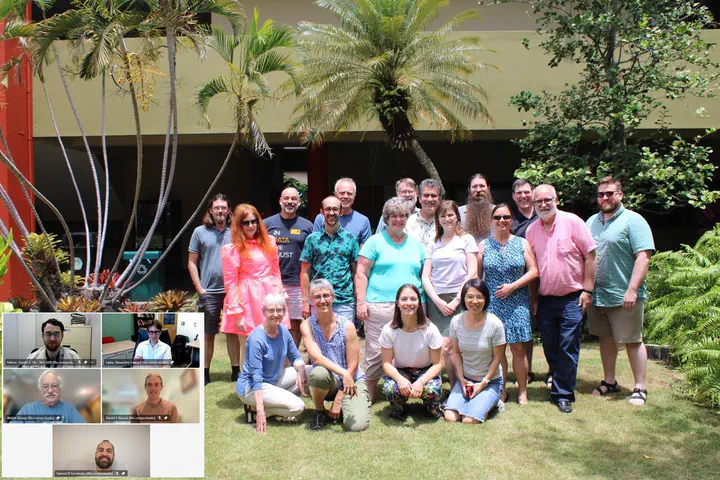2024 NCCC170 Annual Meeting
University of Puerto Rico at Mayagüez

Thursday, June 13, 2024
8:00 AM
Registration, check-in, coffee, juice, snacks
8:45 AM
Welcome
RAÚL E. MACCHIAVELLI, Dean and Director, College of Agricultural Sciences, University of Puerto Rico, Mayagüez, PR
RAÚL E. MACCHIAVELLI, Dean and Director, College of Agricultural Sciences, University of Puerto Rico, Mayagüez, PR
9:00 AM
Quantifying evidence for the omnigenic genetic architecture through a simulation study.
ALEX LIPKA, Dept. of Crop Sciences, University of Illinois, Urbana-Champaign, IL
Typical GWAS and GS statistical models make assumptions on genetic architecture that were derived from RA Fisher’s milestone 1918 paper. Empirical findings from GWAS and GS support these assumptions, namely that gene effect sizes underlying complex traits become infinitesimally small and that the resulting genetic value converges to a normal distribution.
More...
9:40 AM
Exploring the options for quantifying uncertainty in derivatives of splines
QUENTIN D. READ, USDA Agricultural Research Service, Raleigh, NC
Fred Breidt, USDA Agricultural Research Service and Dept. of Food, Bioprocessing, and Nutrition Sciences, North Carolina State University, Raleigh, NC.
Generalized additive mixed models (GAMMs) are a powerful tool for flexibly fitting time series data with both fixed and random effects. WE can use semiparametric GAMMs to make inference about bacterial growth curves that may not play well with fully parametric growth equations.
More...
10:20 AM
Morning break
10:40 AM
Integrating genomic, weather, and secondary trait data for multiclass classification
RÉKA HOWARD, Dept. of Statistics, University of Nebraska, Lincoln, NE
The development of genomic selection (GS) methods has allowed plant breeding programs to select favorable lines using genomic data before performing field trials. Improvements in genotyping technology and automated data collection have enabled scientists to characterize genotypes and phenotypes in more precise ways.
More...
11:20 AM
Food insecurity in Puerto Rico
JULIO CESAR HERNANDEZ, Dept. of Agricultural Economics and Rural Sociology, University of Puerto Rico, Mayagüez
JULIO CESAR HERNANDEZ, Dept. of Agricultural Economics and Rural Sociology, University of Puerto Rico, Mayagüez
12:00 PM
Lunch
1:15 PM
A Discrete-Time Zero-inflated Beta Bayesian Model for Disease Prevalence Over Time
CLARK KOGAN, Department of Pharmaceutical Sciences, Washington State University, Spokane, WA
Travis Galoppo, Independent Statistics Consultant, Princeton, NC
Lori Gustafson, USDA APHIS Veterinary Services, Center for Epidemiology and Animal Health, Fort Collins, CO
Marta Remmenga, USDA APHIS Veterinary Services, Center for Epidemiology and Animal Health, Fort Collins, CO
Current methods for estimating disease freedom probabilities in aquaculture combine prior disease freedom probability with data likelihood and introduction probability to produce posterior freedom over time. These methods aim to establish freedom from disease above a design prevalence.
More...
1:55 PM
Systematic Reviews
BRUCE CRAIG, Dept. of Statistics, Purdue University, West Lafayette, IN
NA
More...
2:35 PM
What is Data? The Statistician’s Role in Data Management Planning
SARA DUKE and KATHLEEN YEATER, USDA Agricultural Research Service, Office of the Director, Fort Collins, CO
In 2013, the White House Office of Science Technology Policy released a memorandum (Holdren) which mandated increasing access to the results of federally funded research. Almost 10 years later, Dr. Alondra Nelson (Acting Director, OSTP) updated the memo to reflect “all peer-reviewed scholarly publications authored or co-authored by individuals or institutions resulting from federally funded research are made freely available and publicly accessible by default in agency-designated repositories without any embargo or delay after publication.
More...
3:15 PM
Break
3:30 PM
Statistical consulting training in academia
RÉKA HOWARD, Dept. of Statistics, University of Nebraska, Lincoln, NE
Statistical consulting plays a critical role in advancing research and decision-making, so it is important to provide quality training to students and statisticians in this area to ensure competence, credibility, and ethical standard.
More...
4:10 PM
Open Discussion
4:30 PM
Adjourn
Friday, June 14, 2024
9:00 AM
What SAS and R software users need to know about GLMMs: an example-driven discussion
NORA M. BELLO, USDA Agricultural Research Service, Northeast Area, Beltsville, MD
WALTER STROUP, Dept. of Statistics, University of Nebraska, Lincoln, NE
RAÚL MACCHIAVELLI, College of Agricultural Sciences, University of Puerto Rico, Mayagüez, PR
BRUCE CRAIG, Dept. of Statistics, Purdue University, West Lafayette, IN
MARINA PTUKHINA, Dept. of Statistics, Whitman College, Walla Walla, WA
JULIE COUTON, Loop Returns
This group discussion will target conceptual and methodological best practices that users of generalized linear mixed models (GLMM) should know and address appropriately, regardless of choice of software platform. Using an example driven approach, we further describe software implementation of GLMMs in SAS and R.
More...
10:30 AM
NCCC170 Business meeting
Announcements:
Thank you to our local host Raul Macchiavelli and program chair Kathy Yeater Welcome to new NCCC170 members Preparation of 2023-2024 annual report: Request information on papers, presentations, awards, etc.
More...
12:00 PM
Lunch